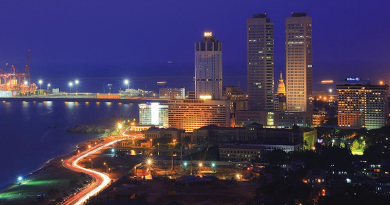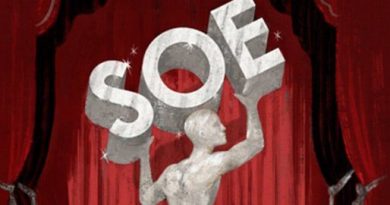Sri Lanka needs a narrower inflation target to stop stagflation, BOP crises: Bellwether
ECONOMYNEXT – Sri Lanka is now in a quagmire of stagflation with inflation at 7.0 percent and growth at 4.0 percent, due to policy errors before and after the 2015/2016 balance of payments crisis.
Usually, following a balance of payments crisis, inflation rise as the currency collapses, and then it tends to fall, partly helped by a re-appreciating exchange rate, though growth will also fall.
This time however, while paying lip service to a flexible exchange rate, the central bank has bought 1.7 billion US dollars, resisted upward pressure coming on the exchange rate which comes when credit weakens and liquidity is withdrawn from money markets.
Amusingly all this has been blamed on coconuts. The currency has been depreciated to target a real effective exchange rate index.
Non-oil Crisis
The 2015/2016 Yahapalanaya BOP crisis has provided important lessons.
Sri Lanka’s recent balance of payments crises were mostly tied to rising oil prices which were then subsidized with printed money. Electricity is also subsidized either via the petroleum utility or directly by the electric utility.

This was the case in the 1999/2000 crises (Brent crude rose from around 10 dollars in Jan 1999 to 26 dollars a barrel by December 1999).
The rupee collapsed, the government changed. Then under UNP led administration with the central bank under Governor A S Jayewardene inflation fell to almost zero despite rising oil prices helped by an appreciating exchange rate and a fuel price formula.
Then in 2004 as money was printed to subsidize oil with Wimal Weerawansa asking for the World Bank plug to be removed (price formula) inflation rocketed and the rupee fell. Then from December 2003 there was a credit collapse after the tsunami and the rupee stabilized and a BOP crisis was avoided.
In 2008 Sri Lanka ran into another crisis as oil was subsidized and Brent crude shot up to 137 dollars a barrel in the last gasp of the ‘mother of all liquidity bubbles’ fired by the US Fed. Brent crude which was about 58 US dollars in February 2007 rose to 138 by June 2008.
The 2011/2012 crisis was also connected to rising oil prices and also a drought which pushed up thermal generation. Brent crude rose from about 78 US dollars a barrel in September 2010 to 126 dollars by May, while a drought pushed up oil imports further.

The central bank in 2011, cut rates despite rocketing credit growth, driven by borrowings from petroleum and power utilities.
The 2015/2016 Yahapalanaya crisis was unique in that oil prices were collapsing in that period. It was purely driven by money printed to accommodate a runaway budget and unchecked liquidity releases.
This helped conclusively show that a 70 year old widely accepted Mercantilist myth that oil imports caused BOP crises in Sri Lanka false completely false.
In fact it is amusing to note that even the International Monetary Fund was saying in early 2015 that low oil prices would help the balance of payments. So did Fitch Ratings, showing that Mercantilist thinking is widespread.
In fact oil prices has no effect on the balance of payments. If oil prices fall, non-oil imports will go up, as people divert spending to other goods (or save more which is then loaned to others as credit by banks).
If oil prices go up and retail prices are also raised – absent subsidies and money printing- non-oil imports will fall. If oil retail prices are kept down, and money is printed non-oil imports will continue unchecked or grow, while oil imports will also grow with printed money generating a BOP crisis.
Like in 2011, there was rate cut in April 2011 as private credit raged and the budget went off the rails. The central bank released 630 billion rupees of liquidity and lost 4 billion US dollars of forex reserves in the crisis.
In Sri Lanka with foreigners now owning bonds, capital flight also starts as soon as the credibility of the soft dollar peg is undermined by the central bank, making for faster draw down on foreign reserves. When rates are cut foreign investors will also get profits if they cut and run.
The 4 billion dollar question is, why did the central bank cut rates?
Bondscam Report
The recently released Bondscam Report presents a clue.
To digress, the bondscam report shows senior officials are remarkably if not hilariously clueless about what goes on in different areas of the country and also the activities of other departments. Some officials are also astonishingly clueless about their own departments.
How people can be so clueless is a mystery. But it also shows why market participants are able to run rings around some of these officials.
To get back to monetary policy, the testimony of key officials to the Bondscam Commission is revealing in terms of the thinking and how the BOP crisis was created in the first place.
It shows that fiscal dominance (pressure from the Treasury to print money) is not the reason for BOP crisis and high inflation.
Nandalal Weerasinghe, Deputy Central Bank Governor and a senior hand in charge of monetary policy was of the view that there was no need for rates to rise in February 2015.
“The witness stated that there was no reason to guide the Interest Rates up. He stated that if there is a need to guide the Interest Rates upwards or downwards, it should be done gradually, within the Policy Corridor,” the commission report said.
“In answer to a Question from the Commission, witness stated that the Board Paper submitted to the Monetary Board on 23rd February 2015, there was no recommendation to guide the Interest Rates upwards and even in the event of being decided that the Interest Rates should be guided upwards, it should have advocated the policy of gradualism. Sudden shock to Interest Rates will create implications to the economy.
The board paper suggested in February that that a 5.0 percent lower floor policy rate be removed but that a 6.5 percent rate be cut to 6.0 percent.
It was not done by the Monetary Board on that day, but a couple of days later Governor Mahendran lifted the rate without going to the monetary board, eventually leading to the Bondscam scandal.
That Sri Lanka was heading into BOP crisis was evident from late 2014 to outside analysts, provided the central bank did not raise rates. And the central bank’s miss-steps were forecasted and chronicled both by this columnist and also reporters.
A glance at some of the headlines shows this.
Oct 2014
Sri Lanka in danger of travelling the PIGS path with low nominal interest rates: Bellwether
Dec 2014
Sri Lanka may lose forex reserve beauty contest amid ultra-low interest rates: Bellwether
Feb 2015
Sri Lanka keeps rates unchanged amid rocketing credit, currency pressure
April 2015
Sri Lanka cuts interest rates dsestpite, state borrowings, revenue concerns
May 2015
Sri Lanka policy rates unchanged amid exchange rate pressure
May 2015
Sri Lanka holds rates amid monetary expansion, rising imports
June 2015
Sri Lanka knocks hard at BOP crisis door: Bellwether
July 2015
Sri Lanka not very concerned about monetary policy due to low inflation: Deputy CB Governor
July 2015
Sri Lanka prints over 100 billion rupees
Aug 2015
Sri Lanka central bank says rising credit a concern; policy rates kept low
Sept 2015
Sri Lanka is not in an immediate BOP crisis: IMF
Oct 2015
Sri Lanka policy rates unchanged, credit growing
Jan 2016 (based on Sept data)
Sri Lanka private credit soars to Rs158bn amid money printing
Feb 2016
Sri Lanka raises policy rates 50bp citing credit and money growth
The April 2015 disastrous rate cut was followed by more liquidity releases like some strategic bomber carpet bombing the banking system, putting Ben Bernanke’s helicopter drops to shame.
After mumbling about many things for more than a year the central bank finally raised rates by a measly 50 basis points in February 2016, after the horse has bolted so to speak.
In fact the rupee was also floated in mid-2015 without a rate hike, in a remarkable turn of events.
Core Inflation
The targeting of a core inflation index by the central bank may also have contributed to the latest crisis.
In early 2015 Sri Lanka’s ‘core inflation’ a misleading inflation measure where many items such as oil and food are taken off was low. Core-inflation is particularly dangerous over short periods.
Even Former Deputy Governor W A Wijewardene, a definite inflation hawk, told the Commission he did not see a need to raise rates in February 2015 as core inflation was low.
Core inflation was indeed low.

In fact a 2006 base index showed that ‘core inflation’ was 2.1 percent in January 2015 and it fell to 0.8 percent in February.
At the time headline inflation was shown as 3.2 percent in January and 0.6 percent in February with the 2015 budget having cut fuel and other commodity prices.
In ordinary times a core index tends to show lower levels of inflation when the Fed fires commodity bubbles sending oil, food commodities (and base and precious metals) prices up.
In Sri Lanka after the CCPI index was revised later, the February 2015 core inflation (as well as headline inflation) showed a higher number which was constantly rising.
The question to ask is would the central bank have raised rates earlier if the 2013 base core-inflation index was used? The answer is probably not.
All this shows that Sri Lanka cannot even construct a useful inflation index and using the existing indices are likely to drive the country into a BOP crisis. And then high inflation after the currency collapses.
Core inflation indices are misleading to use in any monetary regime.
The US Fed for example targeted core inflation while commodity prices soared, generating the Great Recession. In a country with a managed exchange rate (soft-peg) targeting a core-inflation index is suicidal.
Supply Shock Deception
In fact Ben Bernanke is a great proponent of another whopper. That so-called ‘supply shocks’ cannot be countered by monetary policy.
Governor Indrajit Coomaraswamy, without doubt a highly capable and outstandingly honest person, has also fallen for this. He has blamed coconuts for 2017 inflation.
No economist or Mercantilist of any repute has claimed that half the inflation is caused by cost-push and half or some other percentage by demand. Mercantilists, James Stuart, John Law onwards, claimed that all inflation was caused by cost factors.
They argued that money supply had little do with it. Of course claims ‘money supply has little to do with inflation’ are again creeping into the discourse as linear statistical relationships between chosen money supply variables and inflation become harder to find.
Money supply, classical Mercantilists argued, adjusted to price increases not the other way around.
Bernanke’s duplicity on supply shocks is easily revealed.
While claiming that supply shocks cannot be contained by monetary policy, he and Greenspan conveniently printed more money amidst productivity gains from technological developments, and muted commodity prices from 2000 onwards, helping create the mother of all liquidity bubbles and the Great Recession.
In other words, these central bankers are quite willing to print money with loose policy to create more inflation in the face of a ‘positive supply shock’. But they are remarkably unwilling to counter a ‘negative supply’ shock with tight policy.
It is through such deceptions that central banking is kept on.
In any case the price increase of one or two goods cannot cause the general price level to increase over any significant length of time, unless there is monetary accommodation. In general, large increases in the price of one or two goods will leave people with less money to spend on other goods.
If one accepts that a central bank can only contain core-inflation and not the inflation that everyone feels (headline inflation), then inflation targeting should be abandoned altogether.
That is why the inventors of inflation targeting deliberately set a real inflation target in the form of so-called headline inflation, instead of an imaginary one like core-inflation.
The Depreciation Deception
Another deception long practised by central bankers is to try to minimize the effects of depreciation.
When a currency falls from say 100 to the dollar for example the price of exported and imported goods will double.
If tea was priced in the export market at 2 dollars a kilo (200 rupees), before depreciation the and sugar at 50 rupees kilo, after depreciation tea will go up to 400 rupees in a short time. A kilo of sugar will double to 100 rupees a kilo immediately.
Eventually the price increases of traded goods will be passed on to non-traded goods and services, subject to any productivity improvements. Any currency appreciation can reverse the effects as well.
Though the price of the dollar has inflated 100 percent in rupees, just like the price of sugar inflated 100 percent, the depreciation is calculated in such a way as to say it was only 50 percent (i.e the value of the rupee has halved compared to the dollar).
If the rupee falls to 10,000 to the US dollar, the depreciation is calculated as 99 percent only. At 20,000 to the dollars it is around the same.
For example from December 2014 to December 2017 the rupee fell from 131 to the US dollar to 152.8 to the US dollar which is a rupee/dollar inflation of 16.6 percent.
The December 2014 date is a pretty good starting point since the rupee has been stable for a long time prior to that and it can be assumed that most or all of the effects of the 2012 currency collapse had been dissipated by that time.

The CCPI (revised again) went up from 105 to 122.9 or 17.05 percent. In a hilarious development the core inflation index went up from 106.1 to 124.9 points or 17.72 percent, which is higher than the increase in the headline inflation.
So what does that mean? The central bank is responsible for all the headline inflation and then some?
In a pegged exchange rate the total inflation that is created is the domestic inflation (from currency depreciation and demand pressure) plus the inflation created by the anchor central bank, in Sri Lanka’s case the Fed.
It is true that the domestic demand pressure is now down. With dollar purchases being sterilized, the central bank cannot create any demand pressure per se. In fact listed companies are seeing a narrowing of margins and gross profits, which shows that demand pressure is not there.
However inflation is still being created by currency depreciation by the central bank and also by the Fed. This currency depreciation, in a bid to target a REER index can create full blown stagflation and delay a recovery in credit as domestic purchasing power is destroyed.
Inescapable Reality
Whatever pegged central bankers say they cannot escape a self-evident reality. Whether the currency is defended to prevent it from weakening or to prevent it from going up, (like now), it is a peg.
As a result – whether they like it or not – the domestic money supply is going to be determined by the balance of payments. When credit growth goes up, if the central bank resists interest rates hikes by printing money, a BOP crisis will develop due to the misalignment of the money supply with the balance of payments.
This is why stable financial centres raise their policy rates when the US raises rates.
In other words if liquidity is released (money is printed) when credit demand goes up to resist rate rises in a peg, a BOP crisis is the result.

This column has previously pointed out that in March 2016 policy suddenly improved as excess liquidity was allowed to run and 100 plus sterilization stopped.
Until then the central bank’s domestic operations department was injecting cash through reverse repo auctions and outright purchases, at volumes exceeding the outflows, rapidly making the BOP crisis worse.
The Bondscam Report shows that it was actually Arjuna Mahendran who gave the order to stop it.
“On or about 03rd March 2016, Mr. Mahendran had telephoned Mr. Rodrigo (head of domestic operations) and instructed him, that the conduct of Reverse REPO Auctions should be immediately stopped, so as to stop the injection of liquidity into the market through Open Market Operations.
“In this connection, Mr. Rodrigo said that the “Governor telephoned me in the morning, and said to immediately stop conducting of reverse REPO Auctions.”.
“When the Commission of Inquiry asked the witness why Mr. Mahendran had issued such instructions, he said, that Mr. Mahendran had mentioned that the CBSL had earlier increased the Statutory Reserve Requirement in an effort to reduce Liquidity and that the intention of the CBSL was to “drain liquidity.”
“Mr. Mahendran had said that, in this background, Liquidity should not be injected into the market by CBSL and that the CBSL wanted Interest Rates to move up.”
Whatever Mahendran’s faults, and whatever the motivation, he was spot on regarding ending cash injections. Until then the central bank seemed to have been unaware of what it was doing.
Overnight Price Signal
The whether or not the dollar peg is under pressure can be seen by the way the overnight interbank market interest rates behave.
Overnight gilt backed repo rate was a little above the 5.0 percent ‘lower policy rate floor’ until February 27, when ex-Governor Mahendran ordered its removal outside the monetary policy meeting. Rates then moved towards 7.0 percent, but in April rates were cut back to 6.0 percent.
Until March the domestic operations department continued to pour liquidity sterilizing over 100 percent of outflows from currency defensive keeping overnight rates near the 6.0 percent floor of the policy corridor instead of the ceiling rate.
From March rates hit the ceiling of the policy corridor at last, after the Governor telephoned the head of domestic operations and told him to “immediately stop conducting of reverse REPO Auctions.”
Such is the fate of the people of Sri Lanka.
Even then cash injections continued through bill purchases, sterilizing 100 percent, but money was no longer in excess and some banks were borrowing through the window at the highestr rate.
A perusal of both the domestic asset stock (T-bills of the central bank) and the overnight rates show that the 205/2016 BOP crisis ended somewhere around May/June 2016.
Now with rates hitting the floor of the corridor, the central bank is resisting a further fall based on market rates. It can cut rates without causing any damage to inflation. If rates are cut the credit cycle will turn faster.
However the central bank should also allow the exchange rate to appreciate a little to head off the inflation from the Fed. In fact it could have done so many months ago.
External conditions are hotting up now. Stock markets around the world are hitting new records. Oil is rising. Oil at 100 dollars a barrel, gold at 1,700 may return, unless the Fed tightens and withdraws its mountain of excess liquidity pretty fast.
In the US companies that are not much leveraged may be able to stand higher interest rates.
Countries with better pegs from China to Malaysia are already allowing the exchange rate to appreciate against the dollar. Floating rates are floating up.
Whether this phenomenon will moderate the REER index (through a fall in the nominal effective index) and reduce the need to depreciate and generate more inflation remains to be seen.
One mercy of defending the peg, and having BOP crises in quick succession – even if the currency is not allowed to re-appreciate – is that banking crises are avoided.
If an inflationary crawling peg like 2001-2008 on or the 1980s, is operated (helped by REER targeting), bubbles will also become bigger and finance companies and banks will get into trouble when rates are eventually hiked.
Sri Lanka’s planned modified inflation targeting regime is full of holes. It is not just the over-dependence on targeting core-inflation that is troubling. But there is also a plan to manage the exchange rate with forex auctions, indicating a glorified peg will be operated.
A 4-6 percent inflation target will then give enough room for the central bank to delay rate hikes in 2019, sterilize the forex auctions, and run headlong into another BOP crisis. And then an ‘overvalued currency’ will be blamed.
This column is based on ‘The Price Signal by Bellwether‘ published in the February 2017 issue of the Echelon Magazine. To read Bellwether columns as soon as they are published, subscribe to Echelon Magazine at this link. The i-tunes app can be downloaded from here.




